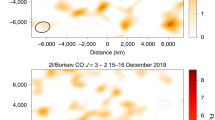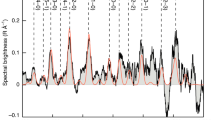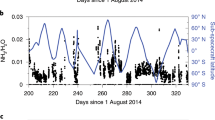Abstract
The composition of ices in comets may reflect that of the molecular cloud in which the Sun formed, or it may show evidence of chemical processing in the pre-planetary accretion disk around the proto-Sun. As carbon monoxide (CO) is ubiquitous in molecular clouds1,2, its abundance with respect to water could help to determine the degree to which pre-cometary material was processed, although variations in CO abundance may also be influenced by the distance from the Sun at which comets formed3,4,5. Observations have not hitherto provided an unambiguous measure of CO in the cometary ice (native CO). Evidence for an extended source of CO associated with comet Halley was provided by the Giotto spacecraft6,7,8,9, but alternative interpretations exist10. Here we report observations of comet Hale–Bopp which show that about half of the CO in the comet comes directly from ice stored in the nucleus. The abundance of this CO with respect to water (12 per cent) is smaller than in quiescent regions of molecular clouds, but is consistent with that measured in proto-stellar envelopes11, suggesting that the ices underwent some processing before their inclusion into Hale–Bopp. The remaining CO arises in the coma, probably through thermal destruction of more complex molecules.
This is a preview of subscription content, access via your institution
Access options
Subscribe to this journal
Receive 51 print issues and online access
$199.00 per year
only $3.90 per issue
Buy this article
- Purchase on Springer Link
- Instant access to full article PDF
Prices may be subject to local taxes which are calculated during checkout




Similar content being viewed by others
References
Rank, D. M., Townes, C. H. & Welch, W. J. Interstellar molecules and dense clouds. Science 174, 1083–1101 (1971).
Turner, B. E. Recent progress in astrochemistry. Space Sci. Rev. 51, 235–337 (1989).
Mumma, M. J. Organic volatiles in comets: Their relation to interstellar ices and solar nebula material. Astron. Soc. Pacif. Conf. Ser. 122, 369–396 (1997).
Mumma, M. J., Weissman, P. R. & Stern, S. A. in Protostars and Planets, III(eds Levy, E. H. & Lunine, J.I.) 1177–1252 (Univ. Arizona Press, Tucson, 1993).
Sandford, S. A. & Allamandola, L. J. The condensation and vaporization behavior of H2O:CO ices and implications for interstellar grains and cometary activity. Icarus 76, 201–224 (1988).
Eberhardt, P. et al. . The CO and N2 abundance in comet P/Halley. Astron. Astrophys. 187, 481–484 (1987).
Huebner, W. F., Boice, D. C. & Sharp, C. M. Polyoxymethylene in comet Halley. Astrophys. J. 320, L149–L152 (1987).
Huntress, W. T., Allen, M. & Delitsky, M. Carbon suboxide in comet Halley? Nature 352, 316–318 (1991).
Meier, R., Eberhardt, P., Krankowsky, D. & Hodges, R. R. The extended formaldehyde source in comet P/Halley. Astron. Astrophys. 277, 677–690 (1993).
Greenberg, J. M. & Li, A. From interstellar dust to comets: the extended CO source in comet Halley. Astron. Astrophys. 332, 374–384 (1998).
Chiar, J. E. et al. . Processing of icy mantles in protostellar envelopes. Astrophys. J. 498, 716–727 (1998).
Biver, N. et al. . Substantial outgassing of CO from comet Hale–Bopp at large heliocentric distance. Nature 380, 137–139 (1996).
Biver, N. et al. . Evolution of the outgassing of comet Hale–Bopp (C/1995 O1) from radio observations. Science 275, 1915–1918 (1997).
Womack, M., Festou, M. C. & Stern, S. A. The heliocentric evolution of key species in the distantly-active comet C/1995 O1 (Hale–Bopp). Astron. J. 114, 2789–2795 (1997).
Greene, T. P., Tokunaga, A. T., Toomey, D. W. & Carr, J. S. CSHELL: A high spectral resolution 1–5 µm cryogenic echelle spectrograph for the IRTF. Proc. SPIE 1946, 311–324 (1993).
Dello Russo, N., DiSanti, M. A., Mumma, M. J., Magee-Sauer, K. & Rettig, T. W. Carbonyl sulfide in comets C/1996 B2 (Hyakutake) and C/1995 O1 (Hale–Bopp): Evidence for an extended source in Hale–Bopp. Icarus 135, 377–388 (1998).
Dello Russo, N. et al. . Direct detection of water in comet C/1995 O1 (Hale–Bopp). Icarus(submitted).
Herzberg, G. Spectra of Diatomic Molecules(Van Nostrand Reinhold, New York, 1950).
Weaver, H. A. et al. . Infrared spectroscopy of comet Hale–Bopp. Earth Moon Planets(in the press).
Lämmerzahl, P. et al. . Expansion velocity and temperatures of gas and ions measured in the coma of comet P/Halley. Astron. Astrophys. 187, 169–173 (1987).
Boice, D. C., Sablik, M. J. & Konno, I. Distributed coma sources and the CH4/CO ratio in Comet Halley. Geophys. Res. Lett. 17, 1813–1816 (1990).
Crifo, J. F. Ageneral physicochemical model of the inner coma of active comets. 1. Implications of spatially distributed gas and dust production. Astrophys. J. 445, 470–488 (1995).
Xie, X. & Mumma, M. J. Monte Carlo simulation of cometary Atmospheres: Application to Comet P/Halley at the time of the Giotto Spacecraft encounter. II. Axisymmetric model. Astrophys. J. 464, 457–475 (1996).
Combi, M. R. Time-dependent gas kinetics in tenuous planetary atmospheres: The cometary coma. Icarus 123, 207–226 (1996).
Xie, X. & Mumma, M. J. The effect of electron collisions on rotational populations of cometary water. Astrophys. J. 386, 720–728 (1992).
Biver, N. et al. . Long term evolution of the outgassing of comet Hale–Bopp from radio observations. Earth Moon Planets(in the press).
Kunde, V. G. & Maguire, W. C. Adirect integration transmittance model. J. Quant. Spectrosc. Rad. Transf. 14, 803–817 (1974).
Rothman, L. S. et al. . The HITRAN molecular database: Editions of 1991 and 1992. J. Quant. Spectrosc. Rad. Transf. 48, 469–507 (1992).
Crovisier, J. Rotational and vibrational synthetic spectra of linear parent molecules in comets. Astron. Astrophys. Suppl. 68, 223–258 (1987).
Huebner, W. F., Keady, J. J. & Lyon, S. P. Solar photo rates for planetary atmospheres and atmospheric pollutants. Astrophys. Space Sci. 195, 1–294 (1992).
Green, S. F., McDonnell, J. A. M., Pankiewicz, G. S. A. & Zarnecki, J. C. in 20th ESLAB Symposium on the Exploration of Halley's Comet Vol. 2, 81–86 (SP-250, ESA, 1986).
Jewitt, D. & Matthews, H. E. Particulate mass loss from comet Hale–Bopp. Astron. J. 117, 1056–1062 (1999).
Acknowledgements
This work was supported through the NASA Planetary Astronomy Program. We thank the staff of the NASA Infrared Telescope Facility for their support throughout our comet Hale–Bopp observing campaign. The IRTF is operated by the University of Hawaii under contract to NASA. We thank J. Crovisier for comments which improved the manuscript.
Author information
Authors and Affiliations
Corresponding author
Rights and permissions
About this article
Cite this article
DiSanti, M., Mumma, M., Russo, N. et al. Identification of two sources of carbon monoxide in comet Hale–Bopp. Nature 399, 662–665 (1999). https://doi.org/10.1038/21378
Received:
Accepted:
Issue Date:
DOI: https://doi.org/10.1038/21378
This article is cited by
-
Reservoirs for Comets: Compositional Differences Based on Infrared Observations
Space Science Reviews (2008)
-
Distributed Sources in Comets
Space Science Reviews (2008)
-
Putting the CO in coma
Nature (1999)
Comments
By submitting a comment you agree to abide by our Terms and Community Guidelines. If you find something abusive or that does not comply with our terms or guidelines please flag it as inappropriate.



